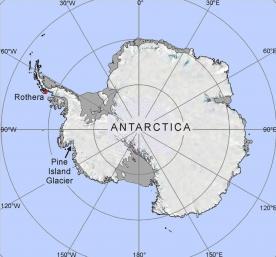Warm ocean under Antarctic glacier
 0 Comment(s)
0 Comment(s) Print
Print E-mail
China.org.cn, June 28, 2011
E-mail
China.org.cn, June 28, 2011
Pine Island Glacier is a large ice stream flowing west-northwest along the south side of the Hudson Mountains into Pine Island Bay, Amundsen Sea, Antarctica.

It was mapped by the United States Geological Survey (USGS) from surveys and United States Navy air photos, 1960—66, and named in association with Pine Island Bay. The area drained by Pine Island Glacier comprises about 10% of the West Antarctic Ice Sheet.
Satellite measurements have shown that the Pine Island Glacier Basin has a greater net contribution of ice to the sea than any other ice drainage basin in the world and this has increased due to recent acceleration of the ice stream.
An international team of scientists from Lamont-Doherty Earth Observatory and British Antarctic Survey has discovered that due to an increased volume of warm water reaching the cavity beneath Pine Island Glacier in West Antarctica, it’s melting 50 percent faster than it was 15 years earlier.
The glacier is currently sliding into the sea at a rate of 2.5 miles a year, while its ice shelf (the part that floats on the ocean) is melting at about 80 cubic kilometres a year. "More warm water from the deep ocean is entering the cavity beneath the ice shelf, and it is warmest where the ice is thickest," said lead author, Stan Jacobs, an oceanographer at Columbia University’s Lamont-Doherty Earth Observatory.
In 2009, Jacobs and colleagues sailed to the Amundsen Sea aboard the icebreaking ship Nathaniel B. Palmer to study the region’s thinning ice shelves — floating tongues of ice where land bound glaciers meet the sea. One goal was to study oceanic changes near Pine Island Glacier, which they had visited in an earlier trip in 1994. The researchers discovered that melting beneath the ice shelf had risen by about 50 percent.
Although regional ocean temperatures had also warmed slightly, by around 0.2 degrees C, that was not enough to account for the jump.
The local geology offered one explanation. On the same cruise, a group led by Adrian Jenkins, a glaciologist at British Antarctic Survey (BAS) and study co-author, sent an automated submarine called Autosub3 under the ice shelf, which revealed an underwater ridge (mountain) on the sea floor. The team concluded that the ridge had once slowed the glacier like a giant retaining wall. When the receding glacier detached from the ridge, some time before the 1970s, the warm deep water gained access to deeper parts of the glacier.
Over time, the inner cavity grew, more warm deep water flowed in, more melt water flowed out, and the ice thinned. With less friction between the ice shelf and seafloor, the land bound glacier behind it accelerated into the sea. Other glaciers in the Amundsen region have also thinned or widened, including Thwaites Glacier and the much larger Getz Ice Shelf.
Dr Adrian Jenkins from British Antarctic Survey said, "Our research shows that the glacier melt rate has increased significantly because more warm water is circulating beneath it. It appears that the thinning of the ice shelf that has resulted from the higher melt rates is what has allowed the circulation to strengthen. It’s evidence of a complex feedback between glacier dynamics, seabed topography and ocean circulation that we need to understand if we are to say how Pine Island Glacier will evolve in the future.
The Pine Island and Thwaites Glaciers are two of Antarctica's five largest ice streams. Scientists have found that the flow of these ice streams has accelerated in recent years, and suggested that if they were to melt, global sea levels would rise by 0.9—1.9 m (1—2 yards), destabilizing the entire West Antarctic Ice Sheet and perhaps sections of the East Antarctic Ice Sheet.[10]
In 1981 Terry Hughes proposed that the region around Pine Island Bay may be a "weak underbelly" of the West Antarctic Ice Sheet. This is based on the fact that, unlike the majority of the large West Antarctic ice streams, those flowing into the Amundsen Sea are not protected from the ocean by large floating ice shelves. Also, although the surface of the glacier is above sea level, the base lies below sea level and slopes downward inland, this suggests that there is no geological barrier to stop a retreat of the ice once it has started.





